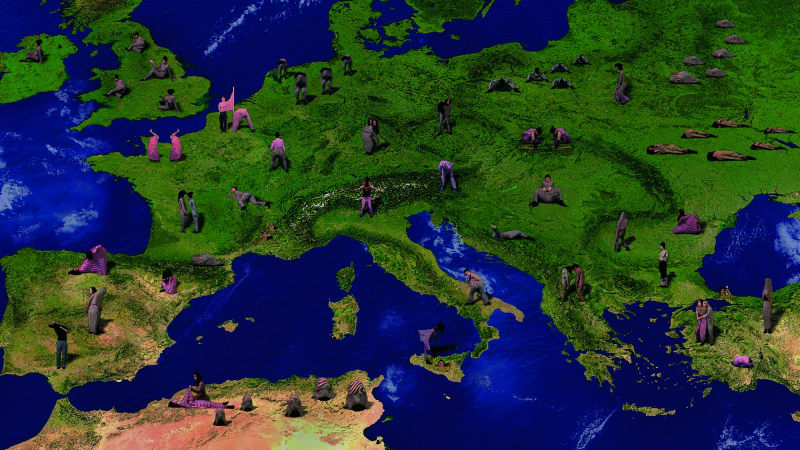The exhibition introducing the artist’s video work titled “Fluxes of Girls on Europe” will open on the 5th of November
Gallery Nev Istanbul hosts the new video work of Inci Eviner; Girls in Europe for the second exhibition held in the 2010-2011 season.
Once again, İnci Eviner invites the viewers to the secure environment of visuality, yet exposing them to surprises. The seductive appeal of the moving pictures viewed at first sight, gradually turns into uncanny traps. The viewer can only experience the unique language of Eviner by unraveling step by step the layers of meaning hidden in the picture. As for the uncanny experience, one feels the traces of curiosity, terror, love, entertainment, hope, shy girls, custom murders and birds’ nests.
In her recent video works titled New Citizen and Harem, İnci Eviner developed a unique language. For this new quest which might be defined as moving picture, the artist says; “It is an action against the symbolic order of the stable image. Whatever it is, the stable image can be trapped by symbolism or a kind of iconography. On the other hand, when the body makes an uncanny movement which is against its look and stand, and when we perceive it with temporary gestures, some other kind of energy is revealed”.
In Emre Baykal’s words, Inci Eviner “…whose artistic career is concurrent to and progressing at the same pace with the development process of Turkish contemporary art, does not take nourishment from the discourses and sources accelerating the process, and in this way, follows its own unique and individual course with persistence, rather than being parallel to this process…”. In 2009, the artist exhibited Harem in Lille and New Citizen at the Paris Mac/Val Museum. Later on, Harem was exhibited in Gallery Nev İstanbul and the Whitechapel Gallery in London. Having exhibited her recent works at the Vienna Art Fair, Mario Mauroner Gallery in Vienna and TBA21, Eviner participated in various exhibitions in the Philadelphia Museum of Art and Bonniers Konsthall in Stockholm. New Citizen was included in “From Traditional to Contemporary” exhibition at İstanbul Modern. The video work she produced on the European Union Parliament building is still on display at Busan Biennial in Korea.
Eviner makes the following comment on her new visual language which she developed after working for a long time: “There is nowhere in the world that we can feel secure and our minds are also insecure… Perhaps, there has never been one except for some illusions. When I observe which political visions are developed against these, I see that there has been no progress made and I continuously get disappointed. I am trying to view our own realm of existence… I am trying to reveal the violence hidden in our behaviors involved in our limited humane actions. What happens in our naked daily lives among all these?.. I am trying to capture those very gestures through the strategies like dining, table, family, jostling and shoving each other, malice, tenderness, sexuality, treason and conspiracies.”
For Girls in Europe, Eviner utilizes the European map as space for the work: “…I am investigating how space shapes our lives with its memory and structure. As an extension of the body, space interests me. I am trying to discover how power operates on our bodies and changes them. Therefore, I prefer moving images and pursue this question; could this state become a new opportunity for resistance? By destroying the codes of already existing spaces, I am providing a space for ‘existence’. I am not creating an abstracted space or image. I am working with given spaces because those spaces are living spaces shaped by a certain school of thought. You see, that rational thought is standing against what I consider irrational and subconscious!”
Girls in Europe is part of a series of works which started in Lille and went on with the exhibition at Mac/Val Museum. The work searches for a new position for the other while it tries to create a realm of existence for the individual between the law and violence. For Eviner, Europe is an ‘idea’ that we have to confront with since it produces discourses and representations, makes definitions and judgments. At the same time, this is the result of an inevitable argument for our own identity. In Girls in Europe, the European continent is invaded by girls from North Africa, unknown corners of the world and Anatolia, who ridicule borders, challenge and demand living spaces. As in Harem, in this fiction, Eviner takes up the comeback of the suppressed and the freedom of expression she allows to each girl, sometimes as the expression of violence and sometimes of joy. The viewers who spend some time with these moving pictures produced with the video technique can join the narrative by establishing their own form of perception and discover the new forms of energies among the gestures. The fact that there is no linear or hierarchic narrative forces us to join this energy. This unexpected meeting of video and painting adds a new dimension to pictorial narrative.
